|
|
After blending the California Cabernet Sauvignon with Virginia Tannat, I wanted to run a couple of tests on the wine. At home I measured the pH. My meter measured a pH of 3.8, which I thought was higher than I expected. Since Kathy and I were going to go to Vint Hill Craft Winery to sample our wine in the barrel, I took a sample of the Cab/Tannat blend to test in their lab. The pH was measured at 3.59, a better reading for pH. I caught my own error with the meter at home. The last time I calibrated the pH meter was in the winter. DJ, winemaker at Vint Hill, said he calibrates his meter weekly. The next time I use my pH meter I will calibrate it first.
My Cab/Tannat blend has a pH of 3.59. We then checked the SO2 levels. It recorded 23.22 ppm of SO2. DJ calculated that I needed to add 1 gram of Potassium Metabisulfate to my wine in the six-gallon carboy. We just added 1 gram to the extra wine in the sample that I brought. I then added that to the carboy.
During the winter I used French oak spirals to impart some oak flavors and aromas. I used a heavy French oak spiral for three weeks and a light French oak spiral for five weeks. The wine tastes quite good right now. It looks like we will be able to drink this wine while cellaring the wine we made at wineries.
I’ll save tasting notes for next week’s Cabernet Event on September 2nd.
Cheers,
Terry
I’ve waited for ten months to blend my west coast, California, Cabernet Sauvignon with east coast, Virginia, Tannat. Having family home for my youngest son’s wedding afforded an opportunity to get feedback on potential blends. The wine was to be Cabernet Sauvignon based so I set up four trials with a 10 percent Tannat influence, 20%, 30% and 40%. Family members tasted the different blends and wrote comments about each of them.
The Cabernet Sauvignon without the Tannat added was also excellent. It was a fruit bomb and had a nice dark red color. The tannins were too mild for my liking so the adding of some Tannat made sense. Everyone tasted the 100 percent Cabernet Sauvignon and a 100% Tannat before tasting the blends. What turned out interesting, to me is that most favored the second blend which was 80 percent Cabernet Sauvignon and 20 percent Tannat. Those that didn’t select that blend as their choice selected the 90 percent ten percent blend. I actually liked the 80/20 blend over the others. It offered a black fruit aroma and taste while having good tannins on the fruity finish. The fruit was intense at times and the wine changed while in the mouth to different fruits. Since my thoughts were backed up by the majorit of tasters, I went with the 80/20 blend.
The wine was racked into a carboy and I plan to bottle on Sunday.
The wine we have in barrel at Tin Lizzie Wineworks will be bottled today. I will be at my son’s wedding at the time of bottling, but hope to pick up the wine later during the day.
Cheers,
Terry
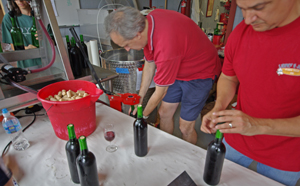 The process of winemaking is long. Even those, who make wine at home from kits, must wait for several weeks. They are advised to wait longer after bottling to consume the wine. If you make wine from grapes, the wait is going to be longer often months or years. Groups making wine at Tin Lizzie Wineworks in Clarksville, Maryland have proceeded to another phase of winemaking: bottling. Mid-August is the time that many red wines aging in barrels will be bottled. The process of winemaking is long. Even those, who make wine at home from kits, must wait for several weeks. They are advised to wait longer after bottling to consume the wine. If you make wine from grapes, the wait is going to be longer often months or years. Groups making wine at Tin Lizzie Wineworks in Clarksville, Maryland have proceeded to another phase of winemaking: bottling. Mid-August is the time that many red wines aging in barrels will be bottled.
Most of the people bottling the Rhone blend of Grenache, Syrah and Carignane saw bottling as just another step in the process rather than an end. Pam Rowe preferred the pressing of the must phase over the bottling. Mindy Myers, however, liked the way everything came together. Fred Rowe and Larry Leak see the process extending past bottling. They are interested in how the wine will taste a year from now and longer. This was the second year of bottling at Tin Lizzie for John and Lisa Viglotti who continue to always learn something new while going through the process.
Just as the wines improved while aging in the oak barrel, there is the potential that they will improve while aging in the bottle. Most wineries age wine in bottles before releasing it to the public. Full-bodied red wines are good wine to age. One benefit of having several cases of a wine you made is to age it for a number of years. With just one case you can drink one bottle a year and note how it changes over time.
There are many phases of the winemaking process and bottling is just one of those phases. What do you think?
Cheers,
Terry
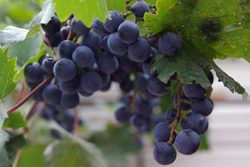 Since the birds were insistent on stealing the Dornfelder, I bought a refractrometer and checked the brix levels. Prior to testing, I tasted the grapes. Although the Dornfelder was developing sweetness, the acid was more prevalent. Seeds were still green but beginning to turn brown. The Dornfelder measured a 16.5 brix. The birds probably have it right. Those pests usually harvest grapes before people. Since the birds were insistent on stealing the Dornfelder, I bought a refractrometer and checked the brix levels. Prior to testing, I tasted the grapes. Although the Dornfelder was developing sweetness, the acid was more prevalent. Seeds were still green but beginning to turn brown. The Dornfelder measured a 16.5 brix. The birds probably have it right. Those pests usually harvest grapes before people.
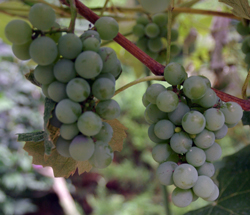 The Niagara seemed to taste sweeter than the Dornfelder. They definitely had the noticeable Niagara aroma. They too were noticeably acidic. The Niagara measured at 12 brix. Perhaps the perceived sweetness was a result of the aroma. Interestingly, the birds haven’t been bothering the Niagara grapes yet. The Niagara seemed to taste sweeter than the Dornfelder. They definitely had the noticeable Niagara aroma. They too were noticeably acidic. The Niagara measured at 12 brix. Perhaps the perceived sweetness was a result of the aroma. Interestingly, the birds haven’t been bothering the Niagara grapes yet.
Sugar levels might be watered down since we had two days worth of thunderstorms which dumped a couple of inches of rain on the vines. I’ll test daily to see the grapes progress. There is so little Dornfelder, that we will only use them for table grapes this year. If the birds go after the Niagara, we won’t have enough for wine, so it will be jelly for this year. On the other hand, if the birds leave them alone, I might be able to get a gallon or two of juice to ferment.
I have a newfound respect for grape growers. Finally, after two years of succumbing to black rot, I managed to aggressively spray my six grape vines that now have very nice fruit. The berries must be good since they are visited by a non-stop wave of birds. With only six vines and dozens of interested spectators, I wonder how growers with acres of vineyards deal with the bird problems.
We have come across solutions during our travels. In Texas we learned that one vineyard introduces road kill to the side of the vineyard. The road kill attracts birds of prey and those birds seem to persuade others to keep their distance. Then there are vineyards that utilize different netting procedures. Others try different sounds such as gunshot or bird distress sounds. Every now and then we’ll observe a vineyard with balloons keeping a watchful eye on the vines.
Since we had success with netting keeping the dear and groundhog from eating all our zucchini and cucumbers, we decided to give the netting a try. It looks easy but proved more difficult to put on than I imagined. On three occasions we found a bird inside the netting just waiting for us to release it. A few more grapes were missing. Since birds are such a pain with six vines, I can’t even imagine the havoc they play with acres of vines.
The grapes are not yet ready to harvest. They have good acid levels, but need to develop higher sugar levels. Apparently the birds must like the acid over the sugar. I am pondering putting out a tray of birdseed in hopes the birds will go for the seed over the grapes. However then I’m going to have to contend with squirrels. It’s amazing that growers can get grapes to the wineries.
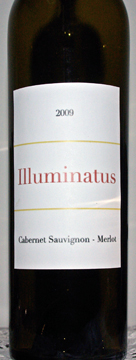 I finally designed a label for the wine we are making at Tin Lizzie Wineworks. I’ll use the same label with modifications for the wine I’m making at home and at Vint Hill Craft Winery. Making the label is easier said than done. Because I have to deal with TTB regs at Vint Hill, I decided to go with a name. I chose Illuminatus, Latin for “giving light to or revealing”. Illuminatus should not be associated with the antagonists of a Dan Brown novel; Illuminati is a different word. I chose Illuminatus because making wine revealed the process of winemaking. I finally designed a label for the wine we are making at Tin Lizzie Wineworks. I’ll use the same label with modifications for the wine I’m making at home and at Vint Hill Craft Winery. Making the label is easier said than done. Because I have to deal with TTB regs at Vint Hill, I decided to go with a name. I chose Illuminatus, Latin for “giving light to or revealing”. Illuminatus should not be associated with the antagonists of a Dan Brown novel; Illuminati is a different word. I chose Illuminatus because making wine revealed the process of winemaking.
It took several months to come up with a word I liked. Other decisions for a label had to be made. It was decided to go with a simple label. The word “Illuminatus” would appear in the center in a ruby color. Above would be the vintage and below the grapes varieties in the wine. Two lines would separate the three areas. Since the wine is a Cabernet Sauvignon-Merlot, I wanted to use a traditional French font. I looked at Garamond, Didot and Caslon. Kathy like the Didot font the best. For the line color, it was decided to go with a gold color. Searching the Internet, I found the CMYK values for six different gold colors. I tried them all and selected one. After printing the label, I tried it on a wine bottle. Simple, traditional and eye catching are some words that come to mind.
I can use the same label design for the Cabernet-Tannat blend I’m making at home. The Cab at Vint Hill though will be a bit more challenging since that label needs TTB approval. My understanding is that I cannot use a vintage or a varietal name on the label. I’ll have to work on this.
For the back label, Tin Lizzie Wineworks is not putting one on. So I wrote a few sentences and the percentages of grapes in the wine. I can put those on by hand, the same with the wine at home. At Vint Hill the back label needs the TTB statement. I write up something and see if it will work. Working the label in Photoshop was the easy part. Making decisions was the harder part that took days.
 I am surprised that my Dornfelder grapes are starting veraison. It seems that it is too early in July. On the other hand, we have had dry weather with numerous days in the 90’s and even three straight days in the 100’s. Last year there were no days in the 100’s and few days in the 90’s. Also last year the grapes never made it to the second week of July scrumming to black rot. So I am on uncharted land with regards to the berries. They do look nice to view though. I tasted a grape that had turned to dark purple. There was no discernable sugar and it was quite tart. The seeds were green. This grape is obviously a distance away from harvesting. I am surprised that my Dornfelder grapes are starting veraison. It seems that it is too early in July. On the other hand, we have had dry weather with numerous days in the 90’s and even three straight days in the 100’s. Last year there were no days in the 100’s and few days in the 90’s. Also last year the grapes never made it to the second week of July scrumming to black rot. So I am on uncharted land with regards to the berries. They do look nice to view though. I tasted a grape that had turned to dark purple. There was no discernable sugar and it was quite tart. The seeds were green. This grape is obviously a distance away from harvesting.
I checked on the Niagara to see if it appeared that they too might have started veraison. As far as I can tell they haven’t. The Dornfelder will look photogenic for the next several weeks as the purple gives another layer of color to the green backdrop. Harvest will come soon enough.
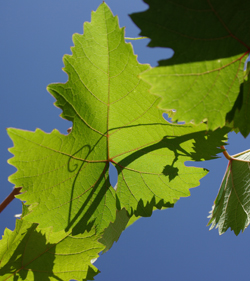 I find myself sitting on the deck marveling at the Dornfelder grapes and the pictures that nature paints. Every day is different. Today I noticed and tried to capture the sunshine casting shadows through the leaves. The bright blue background gave a nice contrast to the light green. Vineyards are beautiful to gaze upon, especially if you can gaze from a shady spot. I find myself sitting on the deck marveling at the Dornfelder grapes and the pictures that nature paints. Every day is different. Today I noticed and tried to capture the sunshine casting shadows through the leaves. The bright blue background gave a nice contrast to the light green. Vineyards are beautiful to gaze upon, especially if you can gaze from a shady spot.
The canvas covering over the four-corner gazebo broke under the weight of a heavy rain years ago. Three summers ago I planted two Dornfelder vines to grow up the sides and provide a canopy. I saw how prolific Dornfelder was when it covered the side of a barn at Fulkerson Winery along Seneca Lake in New York. In the three years the vines haven’t actually provided a canopy, but have provided some beautiful scenes. In retrospect, I should have planted the two Niagara vines; they would have provided a canopy.
For now, I’ll just marvel at the picture painted and occasionally click the shutter.
Just as winemakers shake their heads when the affect of government on wine is discusses, so to do vineyard growers. I had the opportunity to talk to Ron Barrett, winegrower and winemaker at Kinkead Ridge Estate Winery in Ripley, Ohio. Ron mentioned that the state isn’t helpful when they make suggestions that winegrowers need to apply fertilizer to their grapes. Most likely the state doesn’t differentiate the growing of vinefera grapes from other grapes.
Do vinefera grapes even need fertilizer? When Kathy and I planted a row of Petit Manseng in an experimental vineyard in Maryland, we did not add any fertilizer. Even when I planted some Niagara and Dornfelder in my backyard, I did not add any fertilizer. Ron hasn’t added fertilizer to his vineyard that is thriving.
Perhaps if I were growing an acre of Concord and wanted to harvest 15 tons I might add some fertilizer. But tonnage from vinefera grapes is significantly less. Some winegrowers will add compost to the row of vines. This helps the soil. We did meet one grower that adds manure to a row. Several other compost manure with pumice and add the compost. But commercial fertilizer is another question. Do you add commercial fertilizer to your vineyard?
Cheers,
Terry
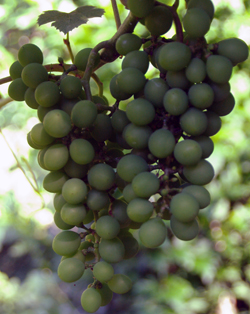 I just happened to notice the Niagara grapes in my backyard. They have increased in size and are definitely much larger than the few vines of Dornfeilder I have planted. What was even more encouraging was the lack of black or brown circles on the grapes. During the last two years we lost our grape crop due to black rot. I’ve tried to be more aggressive with spraying this spring and it may have paid off. I just happened to notice the Niagara grapes in my backyard. They have increased in size and are definitely much larger than the few vines of Dornfeilder I have planted. What was even more encouraging was the lack of black or brown circles on the grapes. During the last two years we lost our grape crop due to black rot. I’ve tried to be more aggressive with spraying this spring and it may have paid off.
While visiting wineries and vineyards in Mendocino County, I met Charlie Barra. Charlie is a walking encyclopedia for vineyards and grapes. His knowledge extends through 64 harvests. Charlie suggested spraying copper sulfate on the grapes to control the black rot. So far, so good. It is nice to see a cluster of grapes hanging on the vines. Of course if they ever make it to harvest time, I’ll have to decide what to do with them, but after two years of crop failure, I’ll cross the bridge when I get there. In the meantime, I’ll continue to spray at ten to fourteen day intervals and keep a watchful eye for problems.
|
|










Do You Fertilize Vinefera Grapes?
Just as winemakers shake their heads when the affect of government on wine is discusses, so to do vineyard growers. I had the opportunity to talk to Ron Barrett, winegrower and winemaker at Kinkead Ridge Estate Winery in Ripley, Ohio. Ron mentioned that the state isn’t helpful when they make suggestions that winegrowers need to apply fertilizer to their grapes. Most likely the state doesn’t differentiate the growing of vinefera grapes from other grapes.
Do vinefera grapes even need fertilizer? When Kathy and I planted a row of Petit Manseng in an experimental vineyard in Maryland, we did not add any fertilizer. Even when I planted some Niagara and Dornfelder in my backyard, I did not add any fertilizer. Ron hasn’t added fertilizer to his vineyard that is thriving.
Perhaps if I were growing an acre of Concord and wanted to harvest 15 tons I might add some fertilizer. But tonnage from vinefera grapes is significantly less. Some winegrowers will add compost to the row of vines. This helps the soil. We did meet one grower that adds manure to a row. Several other compost manure with pumice and add the compost. But commercial fertilizer is another question. Do you add commercial fertilizer to your vineyard?
Cheers,
Terry